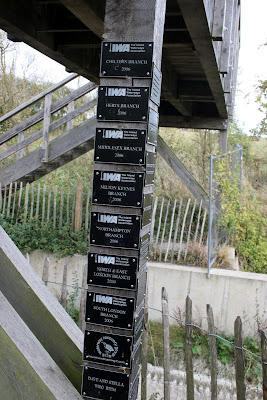This book is well printed and has over 150 high quality between-the-wars monochrome photographs, mostly landscapes, that contain as usual very few people and, of course hardly any vehicles or boats.

A picture that evokes an age of deference!

The boys in blue take to the water!
Most of the plates I have not seen published elsewhere and there is a delightful colour plate of a John Nash painting that is of the Kennet & Avon Navigation at Bath. There is also a marvellous monochrome photograph of a victory fireworks celebration over the Palace of Westminster.

After the blitz this picture speaks for itself

Kennet & Avon Navigation
The date of the publication, 1947, is particularly important. The book flyleaf in fact dates its publication as winter 1947-48. The previous winter was one of the coldest on record with deep snow lying on the ground for many months. As a result the thaw in the spring produced serious flooding so of course the author could not omit reference to this or the need for flood control. Coming at the time of rebuilding Britain after World War II, there is much in the book referring to government plans for new schemes. There is also a complete chapter on the administration of the Thames. This includes a very interesting passage that states that a certain Mr J.H.O. Bunge had recently published a scheme for a Thames barrage that could “remove the tides from the London reaches”. Shades of the Thames Barrier?

The floods of 1947
Since we recently spent some time near Falmouth, I was interested to see how West Country rivers were treated in the book. Rodgers describes them well and includes several literary quotes, but the River Fal, which has such an important estuary that contains the wonderful harbour of Carrick Roads gets just one short sentence that only describes it as being slow-moving and oak fringed. Since it played a significant part in the preparation for D-Day Rodgers certainly missed an opportunity.

King Harry Ferry - presumably in the 1930s
So does Rodgers mention inland navigation and canals? The good news is that he does; the bad news is that it he does it inaccurately. There is good description of flash locks and an historical account of the development of the pound lock. The Thames and Severn canal gets an accurate mention in the section on the Thames. However, the main section dealing with the development canals is in the chapter towards the end of the book on Rivers of the North. It comes close to a description of transport along the River Mersey and introduces the historical background through the Duke of Bridgewater and James Brindley's ideas for the Grand Trunk. This is fairly conventional but after this things go decidedly pear shaped! He appears to ignore all the canals of the Midlands and the Grand Union.

A fine view from a Bridgewater tug (?)
Rodgers refers to the Trent and Mersey Canal as being usually called the Grand Trunk, and there is a very charming photograph of the canal at Burslem. But this is titled “The Grand Junction Canal at Burslem, Staffordshire.” I suppose it could be a problem caused by the editors and not Rodgers himself but such a simple error doesn’t fill you with much confidence. I wonder what Tom Rolt thought? He must have read it.

The caption that is wrong
I looked up the bibliography, which is extensive, and found that it includes a reference to Priestley’s Navigable Rivers and Canals. Having read Priestley, which is full of detail, I wonder how much Rodger’s used it. I can’t see much evidence.
So should boating history enthusiasts seek this book out in their local second book shop or the internet? Of course I got mine cheaply. Despite the minor editorial inaccuracies the book’s plates are very interesting and well produced and they alone make the book well worth seeking. Also if you are a history buff and interested in the organisation of rivers as Britain entered its period of nationalised transport just after the war then you could also find it quite informative in places. And yes, it is in Jim Sheed’s book list.




























